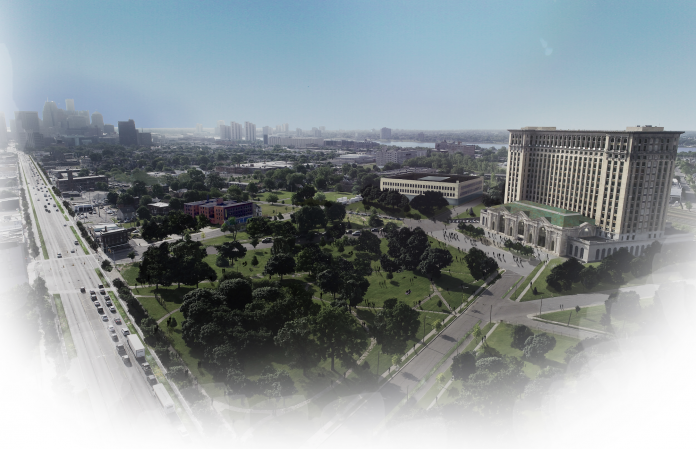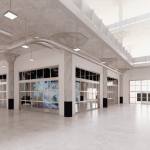
In the mid-1930s, when the Albert Kahn-designed U.S. Parcel Post Office opened next to the august, celebrated Michigan Central Station, there was precious little public fanfare. It was, essentially, a really big warehouse, and at the time it was so common for Kahn’s firm to have a hand in new Detroit-area structures that only a few of their openings were cause for much excitement.
Although the Detroit Free Press wrote in 1934 about the expected start of construction and then-Rep. John Dingell Sr.’s work securing the $1.9 million to pay for it, the paper offered no coverage of its 1936 completion.
That won’t be the case in coming months when that building reopens. It is the first major payoff of Ford Motor Company’s ambitious $950 million investment into the transformation of the long-decaying area. The entire project is branded Michigan Central; it is a gleaming new hub of innovation focused on mobility technology.
The showstopper of that massive effort is, of course, the renewal of the Michigan Central train station as a space for offices, shopping, and public gatherings, which is due to be opened to the public by the end of 2023.
Right now though, the moment finally belongs to the former post office, a wide, squat, chronically-neglected 86-year-old structure long known as “The Book” for its second life, beginning in the 1960s, serving as the book warehouse for Detroit Public Schools. After more than 30 years of abandonment and decay following a devastating fire in 1987, The Book Depository will reopen as the industrial center of Michigan Central, a home to an array of startup entrepreneurs, artisans, and visionaries.
Officials from Michigan Central, LLC — a wholly owned subsidiary of Ford Motor Company formed this year — say it will reopen by the end of 2022, slightly behind schedule on account of delays caused by the COVID-19 pandemic and supply-chain problems.
“Whereas the train station is our historic space, this space is anything but that,” says Katie Rinaldi, the planning lead for the entire development, as she gives Hour Detroit a midsummer tour of both structures under construction.
Regarding The Book Depository, she explains: “We really want to emphasize the architecture here but also emphasize the work that people are doing. We’re going to have concrete floors. We’re going to have concrete ceilings. We wanted to have a little bit of an unfinished feeling because we don’t want it to feel too precious. We want people to come here and really feel like they can get their hands dirty.”
To that end, Michigan Central is collaborating with the firm Newlab on operations of The Book Depository. Newlab reimagined a similarly historic- but-defunct piece of the Brooklyn Navy Yard into an innovation center where hundreds of Newlab’s “member” companies conduct research, test prototypes, and exchange ideas.
As Newlab did in New York, The Book Depository will provide its tenants with an array of small-scale manufacturing services — a woodshop, a metal shop, a 3D printing studio, computer-controlled mills — as amenities.
“You can take something from a napkin sketch to a 3D-printed object to something designed for manufacturing all in-house,” Newlab co-founder David Belt says. “That’s very helpful to entrepreneurs because you don’t have to send the part out and hope it comes back. We staff those shops to allow people to have the kind of product realization expertise that they need in order to make that stuff work.”
Since Newlab and Ford struck their cooperative agreement in mid-2020, Belt has pushed for a design in which the 17,000 square feet designated for those services is in public view.
The idea is to make walking into The Book Depository “a really visceral experience in which you walk in and you understand the type of work that is going to happen here. You understand that this is a really interesting facility for people working at the intersection of hardware and software, and particularly in mobility, where not only can you have a great idea, but you can test, you can build, you can prototype, and you can pilot all within this building or within this campus,” Belt says.
One key to the redesign of The Book Depository has been an effort to respect its original Kahn design but make it more functional, inviting, and inspiring for those who will inhabit it. Its original functions were as warehouses — first for mail, then for books — so little thought was given to how a massive, fortress-like rectangle would feel to those who labored in its center.
Perhaps the most radical alteration to the building, then, was cutting a hole in the center for a light-flooded atrium and elevator bank.
“We had to really reposition the building from storage and inventory to a people place,” says Lily Diego, Detroit design director at the architecture firm Gensler and the designer for The Book Depository.
“We want everyone to have a right to light, so we can flood the building with light. The center of the building really got dark. But then we also wanted it to be open because there might be drones delivering information back and forth, there might be robotic equipment that traverses through the opening versus in an elevator. We really wanted to create a flexible platform for the building to allow any kind of future technology or future mobility company to be able to not feel restrained.”
Read more about the Michigan Central Project in the Hour Detroit interviews with the project’s overseeing architect and the design director of The Book Depository.
Images from the Michigan Central Project
This story is from the Dawn of a New Era feature from the October 2022 issue of Hour Detroit magazine. Read more in our digital edition.
|
|
|























